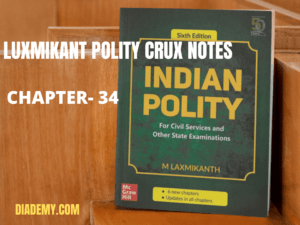
High Court [Articles 214 to 231] – Part VI
| Introduction | Single Integrated Judicial System
High Court below Supreme Court & above the subordinate courts. Top position in Judicial administration of a state. 1862→ Calcutta- Bombay – Madras, 1866 – Allahabad H.C 1950→ Existing H.C of province in British India came to own H.C. Art-214→ each high court for a state. But by 7th CAA 1956→ Common H.C for two are many state or Union Territory (UT). At Present→ 25 H.C, 3 are common (Delhi is the only UT-its own (since 1966). |
| Organisation | CJ (HC) + other judges (not decided by Const. can be altered time to time as president deem necessarily. |
Judges |
Appointment – by President
CJ(HC) → Consultation with CJI + Governor Other Judges→ Concern of CHJ Consisted. Common HC of 2 or more state, govt of all concerned by President. 99th CA 2005→ NJAC unconstitutional and void. |
| Qualification | Citizen, 10 year Judicial office, 10 years judge of H.C
No minimum age No provision of Eminent Jurist. |
| Oath | 219 – by governor |
| Tenure of Judges | No fixed, four provisions
Age 62 Resign President on (Parl. recommendation) On appointed as judge of SC or other judges. |
| Removal of Judges | Misbehaviour or Incapacity, Removal same manner as SC. |
| Salaries and Allowances | 221 – CJ (HC) – 2,50,000
J (HC) – 2,25,000 Pension from – CFI |
| Transfer of Judges (222) | POI can transfer from one HC to another.
On transfer entitled to receive extra salary. |
| Retired Judges | At any time, CJ (HC) to any Retired Judge for temporary period.
Previous consent of POI + appointed person. |
| Independence of HC | 1. Judges of HC are appointed by President in consultation with members of the judiciary itself.
2. They have a security of tenure and can be removed only by the President. 3. They have a fixed salary condition determined by the Parliament 4. Salaries and allowances are charged to the consolidated fund of India and not to the state. 5. Conduct of judges cannot be discussed. 6. Ban on practice after retirement. 7. Power to punish for its contempt 8. Separation from the executive. 9. Jurisdiction cannot be curtailed by Parliament or state legislature. |
| JURISDICTION AND POWERS OF HC | High court of appeal
Protector of FR, interpret the Constitution. At present, a high court enjoys the following jurisdiction and powers: 1. OriginalJurisdiction· Matter of admiralty, will marriage, divorce, company law & contempt of court. · MP + ML election, Dispute regarding Revenue FRs. 2. WritJurisdiction· Art 226 empower H.C to issue writs · Habeas corpus, mandamus, certiorari, prohibition and quo- warrento. · If HC issue any writs to any person authority & govt not only within territorial but outside territorial Jurisdiction, If the cause of action within Jurisdiction (territorial). 3. Appellate Jurisdiction: · Primary court of appeal. · Has both civil and criminal matter appellate jurisdiction · Appellate jurisdiction is wider than original jurisdiction 4. Supervisory jurisdiction: · Power of superintendence over all courts and tribunals functioning in its territorial jurisdiction. · Except military courts and tribunals. 5. Court of record. 6. Power of judicial review: · Power had been curtailed by the 42nd amendment act of 1976 · added by 43rd amendment act of 1977 |
Get all essential Crux notes by clicking here https://diademy.com/product/staticcrux/